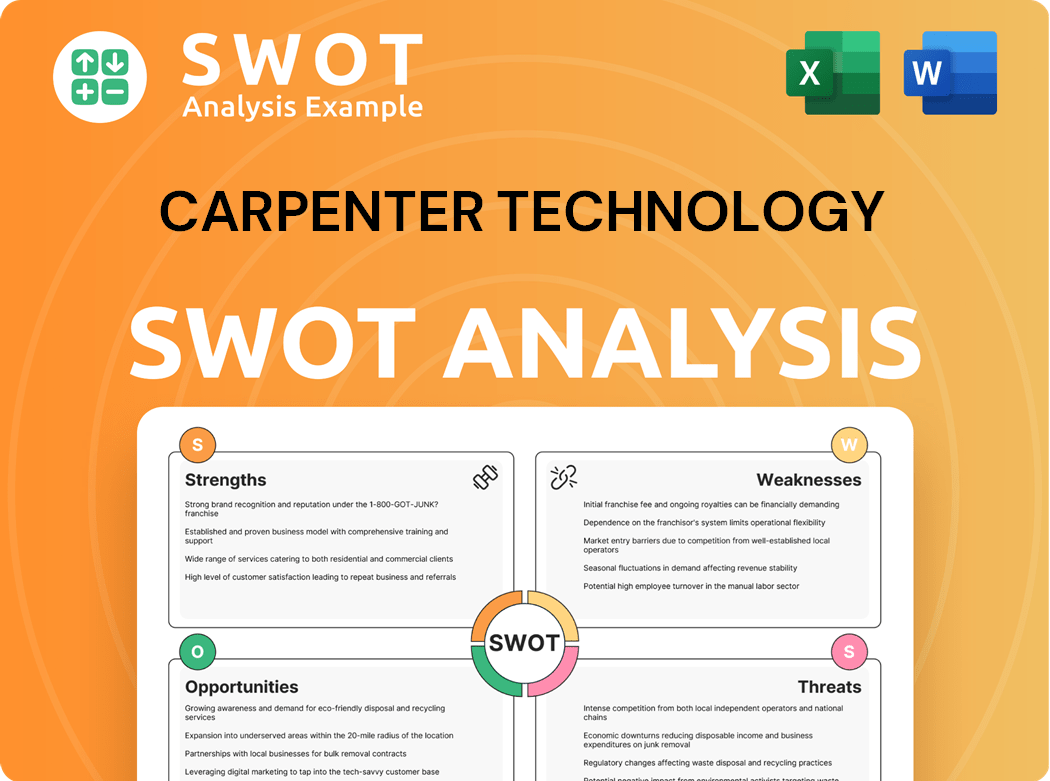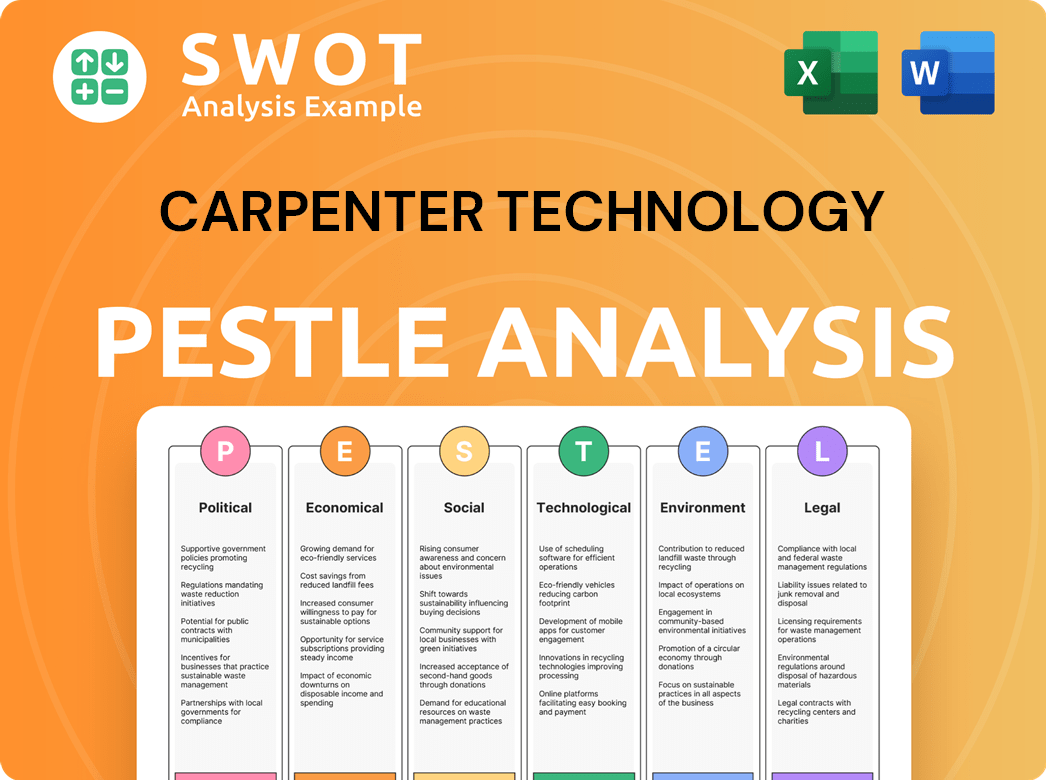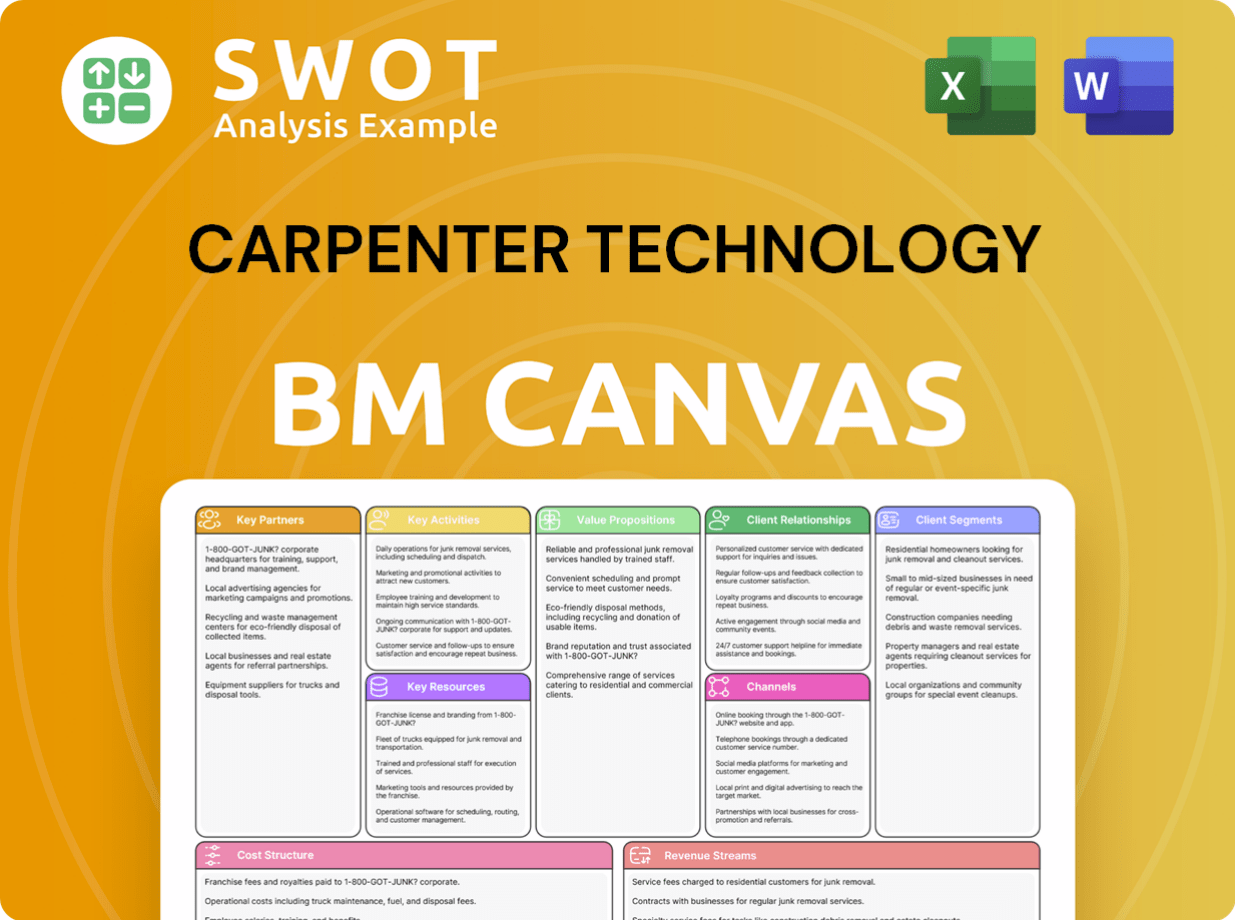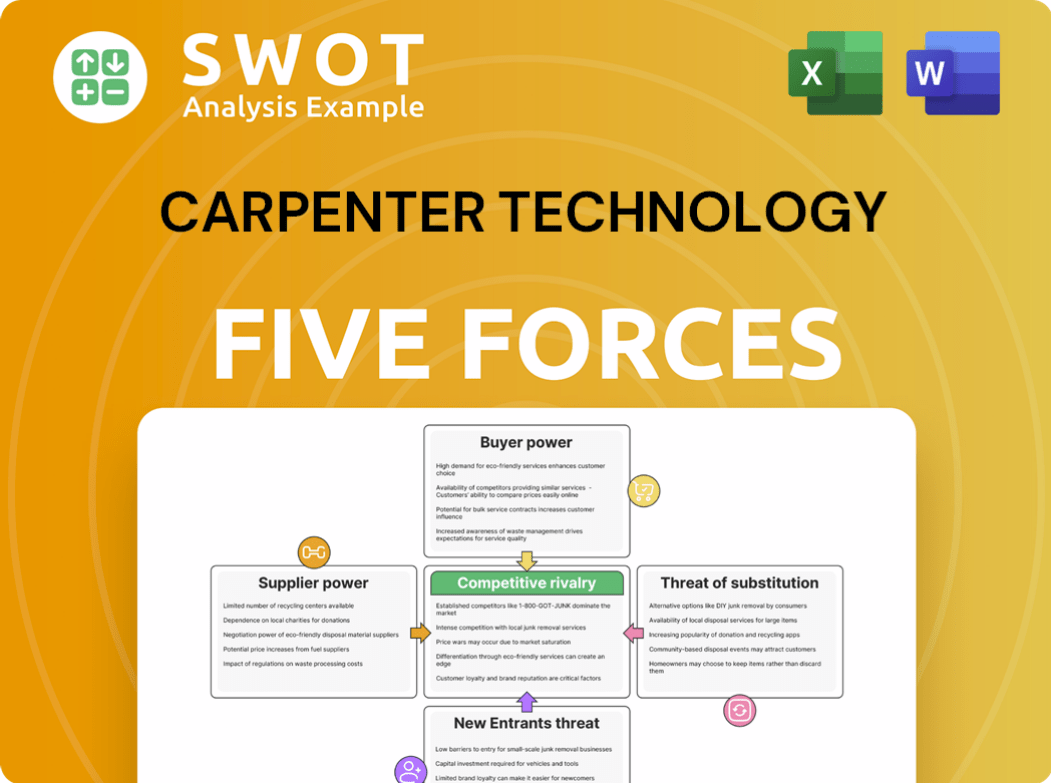Carpenter Technology Bundle
How Did Carpenter Technology Forge Its Legacy?
From penetrating armor in the late 1800s to powering modern marvels, Carpenter Technology's story is one of relentless innovation. This global leader in specialty alloys has consistently pushed the boundaries of what's possible in metal manufacturing. Discover how Carpenter Steel transformed from a regional steelmaker into a titan of industry.

Carpenter Technology's story began in 1889, rooted in the burgeoning iron industry of Reading, Pennsylvania. Its early success, including the development of armor-piercing projectiles, set the stage for its future. Today, Carpenter Technology SWOT Analysis reveals a company that continues to thrive, with impressive financial results like the $2.76 billion revenue in fiscal year 2024. This article delves into the key milestones and innovations that define Carpenter's history, exploring its impact on industries like aerospace and defense.
What is the Carpenter Technology Founding Story?
The story of Carpenter Technology Corporation, or Carpenter Steel, began in 1889. It was a time of industrial growth, and the company's founder, James Henry Carpenter, saw an opportunity in the burgeoning steel industry. His vision and early successes laid the groundwork for what would become a major player in metal manufacturing.
James Henry Carpenter, a former Navy serviceman with a background in construction engineering, founded the company. He was drawn to metallurgy and tool steel manufacturing. The city councilman in Reading, Pennsylvania, recognized the economic potential, encouraging Carpenter to establish his steel-making venture there. The company's early focus on high-quality tool steels proved to be a key strategic decision.
Carpenter Steel Company was incorporated in New Jersey on June 7, 1889. The company quickly secured its first significant order for 3,000 tons of steel. This early success set the stage for future growth and innovation in the specialty alloys market.
The company's initial business model involved leasing a rail-making plant in Reading. This was soon followed by a pivotal contract with the U.S. Secretary of the Navy in May 1890.
- Carpenter Steel secured a contract to develop armor-piercing projectiles.
- James Carpenter's patent for an 'air-hardening steel' manufacturing process was crucial to this success.
- The company rapidly expanded, acquiring the Union Foundry within five months.
- The Union Foundry served as the company headquarters and a specialty steel mill for over a century.
One of the key early milestones for Carpenter Steel was securing a contract with the U.S. Secretary of the Navy in May 1890. This contract was to develop armor-piercing projectiles. James Carpenter's patent for an 'air-hardening steel' manufacturing process was instrumental in meeting this challenge. The company's rapid growth led to the acquisition of the Union Foundry within five months, which served as the company headquarters and a specialty steel mill for over a century. James Carpenter passed away in March 1898.
Carpenter Technology SWOT Analysis
- Complete SWOT Breakdown
- Fully Customizable
- Editable in Excel & Word
- Professional Formatting
- Investor-Ready Format

What Drove the Early Growth of Carpenter Technology?
The early years of Carpenter Technology, then known as Carpenter Steel Company, were marked by swift expansion and a focus on specialty steels. This growth was fueled by strategic acquisitions and a commitment to innovation. A key element of its early success was its ability to develop and supply specialized materials for emerging industries.
Carpenter Steel Company rapidly expanded beyond its initial rail-making plant. The acquisition of the Union Foundry, which became its long-standing headquarters and a specialty steel mill, was a significant early strategic move. This expansion allowed the company to increase its production capacity and diversify its product offerings, setting the stage for future growth in the metal manufacturing sector.
A pivotal moment was a May 1890 contract with the U.S. Secretary of the Navy, leading to the development of armor-piercing projectiles using James Carpenter's patented 'air-hardening steel.' These projectiles were highly effective, contributing to the American victory in the Spanish-American War of 1898. This early success highlighted the company's focus on specialty alloys and its ability to meet the demands of military applications.
Carpenter's 'special' steels played a crucial role in the Wright brothers' maiden flight in 1903, demonstrating its early involvement in the aerospace industry. The company's innovation continued with the development of a prime grade chrome-nickel steel in 1905 and, by 1908, ten other steels used in automobile chassis. The 'Old 16' race car, which won the Vanderbilt Cup in 1908, featured components made of Carpenter steel.
Carpenter Steel Company became a public company in June 1937 through an initial public offering. During World War II, the company's stainless steel was essential for various applications, including engine parts for fighter planes and components for Sherman tanks. The company operated around-the-clock shifts and introduced four new electric-arc furnaces, enhancing control over the melting process. By 1968, the company officially changed its name to Carpenter Technology Corporation.
Carpenter Technology PESTLE Analysis
- Covers All 6 PESTLE Categories
- No Research Needed – Save Hours of Work
- Built by Experts, Trusted by Consultants
- Instant Download, Ready to Use
- 100% Editable, Fully Customizable

What are the key Milestones in Carpenter Technology history?
The Carpenter Technology has a rich history marked by significant milestones in the metal manufacturing industry. From its early innovations to its strategic focus on high-demand sectors, the company has consistently adapted to market changes and maintained a strong position in the specialty alloys market.
| Year | Milestone |
|---|---|
| Late 19th Century | Developed 'air-hardening steel,' enabling the production of armor-piercing projectiles for the U.S. Navy. |
| 1898 | The groundbreaking material contributed to the American victory in the Battle of Manila Bay. |
| 1903 | Specialized steels were used in the engine of the Wright brothers' first successful flight. |
| 1908 | Developed new steels for car chassis, expanding into the automotive sector. |
| December 1917 | Manufactured its first high-strength, chemical-resistant stainless steel. |
| 1928 | Introduced the first free-machining, 'antifriction' stainless steel. |
The company's commitment to innovation is evident in its early development of specialized steels. These advancements extended to various industries, including aerospace and automotive, showcasing the company's ability to create materials for diverse applications.
The development of air-hardening steel was a pivotal innovation, enabling the production of armor-piercing projectiles. This material played a crucial role in the American victory at the Battle of Manila Bay.
The creation of high-strength, chemical-resistant stainless steel in December 1917 was a significant advancement. This innovation found immediate use in airplane engine components and cutlery.
In 1928, the introduction of free-machining, 'antifriction' stainless steel further expanded the company's product offerings. This innovation improved machining processes and enhanced product performance.
Carpenter's specialized steels were used in the engine of the Wright brothers' first successful flight, showcasing the company's early impact on nascent industries. This marked the company's entry into the aviation sector.
By 1908, Carpenter Technology had developed new steels specifically for car chassis. This expansion into the automotive sector demonstrated the company's adaptability and innovation.
The company continuously diversified its product range to meet the evolving needs of various industries. This included the development of specialized alloys for aerospace, defense, medical, energy, and transportation sectors.
Throughout its history, Carpenter Technology has faced challenges, including market downturns and competitive threats. The company's strategic focus on high-demand sectors and its ability to drive earnings momentum through improved productivity reflect its ongoing efforts to overcome operational challenges.
The company experienced a decline in business around the time of founder James Carpenter's death in March 1898. However, the company has consistently adapted to market changes.
During the Great Depression in 1934, the company introduced new stainless steels with additives to maintain its market position. This demonstrated the company's resilience.
In fiscal year 2024, aerospace and defense accounted for 59% of sales, highlighting a strategic focus on high-demand sectors. This focus has helped the company maintain its financial performance.
The company has focused on product mix optimization to drive earnings momentum. This strategy involves offering a range of specialized materials tailored to various industries.
Carpenter Technology has implemented strategic pricing actions to improve its financial performance. This includes adjusting prices to reflect the value of its specialized materials.
The company's ability to drive earnings momentum through improved productivity reflects its ongoing efforts to overcome operational challenges. This includes streamlining manufacturing processes and enhancing efficiency.
Carpenter Technology Business Model Canvas
- Complete 9-Block Business Model Canvas
- Effortlessly Communicate Your Business Strategy
- Investor-Ready BMC Format
- 100% Editable and Customizable
- Clear and Structured Layout

What is the Timeline of Key Events for Carpenter Technology?
The Carpenter Steel history is a testament to its innovation and strategic adaptability. Founded in 1889 as Carpenter Steel Company in Reading, Pennsylvania, the company quickly established itself as a leader in metal manufacturing. Early successes, such as securing a contract with the U.S. Navy in 1890, propelled its growth. Through the years, Carpenter Technology has continuously evolved, adapting to market demands and technological advancements.
| Year | Key Event |
|---|---|
| 1889 | Incorporated as Carpenter Steel Company in Reading, Pennsylvania. |
| 1890 | Secured a contract with the U.S. Secretary of the Navy, leading to the development of armor-piercing projectiles. |
| 1896 | U.S. Secretary of the Navy recognizes Carpenter's armor-piercing projectiles as superior. |
| 1898 | Carpenter projectiles are credited in part for the routing of the Spanish fleet in the Battle of Manila Bay. |
| 1903 | Carpenter's 'special' steels are used in the engine of the Wright brothers' maiden flight. |
| 1917 | Manufactured its first high-strength, chemical-resistant stainless steel. |
| 1937 | Became a public company via an initial public offering. |
| 1951 | Introduced 'Stainless 20,' a corrosion-resistant alloy. |
| 1968 | Changed its name to Carpenter Technology Corporation. |
| 2014 | Opened a 500,000-square-foot manufacturing facility in Alabama. |
| 2019 | Invested approximately $40 million in an Emerging Technology Center (ETC) to enhance additive manufacturing capabilities. |
| October 2024 | Reported Q1 Fiscal Year 2025 operating income of $113.6 million. |
| January 2025 | Reported Q2 Fiscal Year 2025 operating income of $118.9 million, a record for a second fiscal quarter. |
| April 2025 | Reported Q3 Fiscal Year 2025 operating income of $137.8 million, the most profitable quarter in company history. |
The company's financial performance has been robust. Q3 FY2025 saw a record operating income of $137.8 million. The company anticipates continued earnings growth beyond fiscal year 2025. This growth is expected to be driven by strong market demand in key end-use markets.
Carpenter Technology plans to increase productivity, optimize product mix, and implement strategic pricing actions. Investment in growth initiatives, such as the recently announced brownfield expansion project, further underscores their long-term strategy. The company's focus is on leveraging its core technical strength in engineered materials.
The company has raised its operating income guidance for the full fiscal year 2025 to a range of $520 million to $527 million. This represents a nearly 50% increase over fiscal year 2024's adjusted operating income. They also project adjusted free cash flow of $250 million to $300 million for fiscal year 2025.
The company projects an operating income outlook of $765 million to $800 million in fiscal year 2027. This represents a compound annual growth rate of 25% over two years. Management believes that market dynamics are only strengthening, which will drive growth past their FY27 earnings target.
Carpenter Technology Porter's Five Forces Analysis
- Covers All 5 Competitive Forces in Detail
- Structured for Consultants, Students, and Founders
- 100% Editable in Microsoft Word & Excel
- Instant Digital Download – Use Immediately
- Compatible with Mac & PC – Fully Unlocked

Related Blogs
- What is Competitive Landscape of Carpenter Technology Company?
- What is Growth Strategy and Future Prospects of Carpenter Technology Company?
- How Does Carpenter Technology Company Work?
- What is Sales and Marketing Strategy of Carpenter Technology Company?
- What is Brief History of Carpenter Technology Company?
- Who Owns Carpenter Technology Company?
- What is Customer Demographics and Target Market of Carpenter Technology Company?
Disclaimer
All information, articles, and product details provided on this website are for general informational and educational purposes only. We do not claim any ownership over, nor do we intend to infringe upon, any trademarks, copyrights, logos, brand names, or other intellectual property mentioned or depicted on this site. Such intellectual property remains the property of its respective owners, and any references here are made solely for identification or informational purposes, without implying any affiliation, endorsement, or partnership.
We make no representations or warranties, express or implied, regarding the accuracy, completeness, or suitability of any content or products presented. Nothing on this website should be construed as legal, tax, investment, financial, medical, or other professional advice. In addition, no part of this site—including articles or product references—constitutes a solicitation, recommendation, endorsement, advertisement, or offer to buy or sell any securities, franchises, or other financial instruments, particularly in jurisdictions where such activity would be unlawful.
All content is of a general nature and may not address the specific circumstances of any individual or entity. It is not a substitute for professional advice or services. Any actions you take based on the information provided here are strictly at your own risk. You accept full responsibility for any decisions or outcomes arising from your use of this website and agree to release us from any liability in connection with your use of, or reliance upon, the content or products found herein.